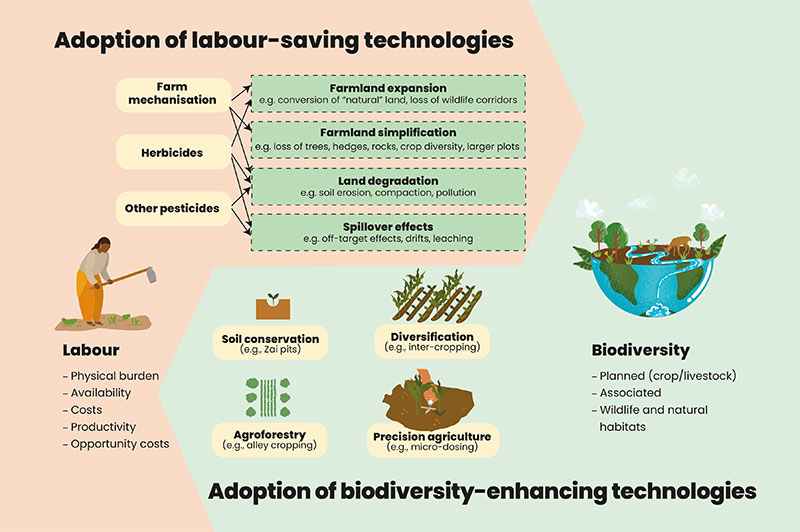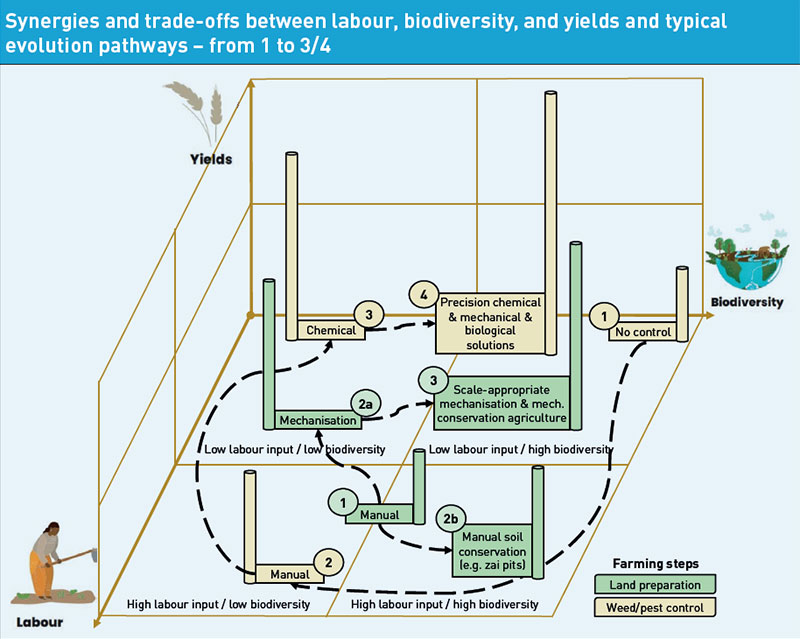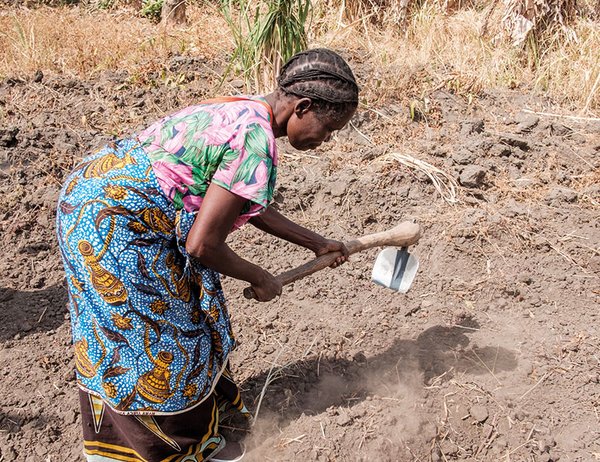 Download this article in magazine layout
Download this article in magazine layout
- Share this article
- Subscribe to our newsletter
Biodiversity-smart agriculture – the role of labour requirements
Biodiversity is declining rapidly in both the Global North and South, a trend that an article in Science Advances from 2015 referred to as the sixth mass extinction. The Living Planet Index of the World Wide Fund for Nature (WWF) and the Zoological Society of London shows an average decline in the population sizes of more than 5,000 key vertebrate species by 69 per cent since 1970. A recent review published in Biological Conservation confirms this, showing that 40 per cent of insect species are facing a decline, with one-third of them on the brink of extinction.
This rapid loss of biodiversity could have significant consequences for food security, warn the authors of the report on the State of the World’s Biodiversity for Food and Agriculture issued by the the UN Food and Agriculture Organization (FAO). This is because biodiversity is key for ecosystem services like pollination, soil formation, nutrient cycling, water maintenance, and pest and disease control – all of which are important for food production. The authors also warn that biodiversity loss can weaken farmers’ ability to cope with climate shocks and limit the access of rural communities to wild food sources such as animals, honey, vegetables, fruits, tubers and nuts.
How agriculture impacts biodiversity
Agriculture impacts biodiversity through two main avenues: the expansion of agricultural land and the intensification of farming practices. Farmland expansion can lead to the destruction and fragmentation of habitats, threatening the survival of species that rely on large habitats. Avoiding farmland expansion is therefore key to biodiversity conservation. Alas, pristine nature is lost rapidly across the world. In Africa, agricultural growth has been significant in the last two decades, but 75 per cent of it has stemmed from converting forests and savannahs into farmland, as shown in a recent study by Thomas Jayne and Pedro Sánchez in Science.
Intensification makes it possible to produce more food on existing farmland, thus preserving land for natural habitats, as long as re-bound effects can be curtailed. India is a success story. FAO data shows that it tripled cereal production in the last decades as part of the “Green Revolution” – without significantly expanding farmland. In Africa, the potential for intensification is still large – studies show that farmers achieve only 25 per cent of what would be possible under their agro-ecological conditions. However, intensification is a double-edged sword. In particular, when badly managed, it can lead to environmental harm due to increased pesticide use and simplification of landscapes to facilitate mechanised farming, among others. This is why the Indian agronomist Mankombu Swaminathan, one of the architects of the “Green Revolution”, now calls for an “Evergreen Revolution”.
Researchers, policy-makers and farmers are increasingly recognising the importance of finding a balance between promoting agriculture and protecting biodiversity. However, when discussing ways to make agriculture more biodiversity-friendly, the focus tends to be on conservation goals and, to some extent, on minimising the trade-offs with land productivity. This is important because low yields are bad for farmers and can lead to more land being used for farming. However, one aspect is often neglected in discussions about biodiversity-friendly agriculture: agricultural labour. This oversight is very problematic, considering the heavy toil of farm work for the world’s 550 million family farms. Moreover, neglecting farm labour needs could ultimately hinder efforts to conserve biodiversity.
Agricultural labour – the neglected factor
Addressing agricultural labour issues is crucial for achieving the Sustainable Development Goals of the United Nations. Across the world, around 10 per cent, and in Africa roughly 35 per cent, of the population live in extreme poverty, mostly in rural farming communities. This is largely because of low labour productivity, which is a key determinant of farmers’ income. Cultivating one hectare of land with manual labour often takes smallholder farmers 800-1,500 hours, depending on the crop. Most of this heavy work has to be done under the harsh (sub)-tropical sun. Climate change will make things worse. Agricultural labour affects men, women and children. The International Labour Organization (ILO) estimates that 70 per cent of child labour occurs in agriculture, affecting the well-being and livelihood opportunities of 112 million children. Moreover, while there is a persistent belief that labour is abundant in the Global South, many regions actually face acute agricultural labour shortages due to ageing, outmigration and structural transformation.
The heavy toil of farming has been a driving force behind humankind’s relentless strive to develop smart technologies. Ox-drawn ards were already used 6,000 years ago in Mesopotamia, while water-powered mills emerged 3,000 years ago in China. In present days, modern technologies such as tractors and herbicides are “gifts from heaven” for many farmers, allowing them to almost decouple agricultural production from agricultural labour. In the USA, farmers obtain 1,470 kg of maize per hour worked, in Kenya, they produce only 1 kg – as shown by Douglas Gollin from the UK’s Oxford University.
The desire to reduce the heavy toil of farming also explains why herbicides are spreading rapidly in the Global South, a trend that Steven Haggblade from Michigan State University, in the USA, calls a “herbicide revolution”. In a study in Mali, he shows that herbicides reduce weeding workloads – one of the most time-consuming and arduous tasks of farming – by up to 90 per cent. In their fieldwork in Burkina Faso, William Moseley from Macalester College and Eliza Pessereau from the University of Wisconsin-Madison, both in the USA, found that herbicides are often referred to as “mother’s little helpers”. In a recent paper, Ghislain Aihounton and Luc Christiaensen from the World Bank show that “modern” production packages including tractors and herbicides allow farmers in Côte d’Ivoire to reduce labour use from 1,568 to 432 hours per hectare.
But while appealing to farmers, such technologies can negatively affect biodiversity through farmland expansion, simplification, land degradation, and spillover effects (also see Figure below). In Zambia, for instance, a study by Ferdinand Adu-Baffour and co-authors from Germany’s University of Hohenheim found that tractors enable farmers to cultivate more land, which increases their incomes but harms the African savannah. Similarly, a comparative study conducted as part of the “Program of Accompanying Research for Agricultural Innovation” in Benin, Kenya, Nigeria and Mali suggests that farmers often remove trees and other landscape elements and enlarge and reshape plots to facilitate the use of tractors. These changes ultimately result in a loss of diversity within farms and the overall landscape. Similar trends have long been observed in many parts of the Global North. The use of agrochemicals can also be detrimental. Pesticides, especially when unregulated or poorly managed, as is often the case, can harm insect populations, soil organisms, groundwater, lakes and rivers.

The downside of agroecological practices
At the same time, as shown in our framework (see Figure above), approaches aimed at promoting biodiversity in agriculture often face resistance from farmers. Despite the potential benefits for local biodiversity, many agroecological practices are not widely adopted because of their high labour requirements. A recent meta-analysis by Sigrun Dahlin from the Swedish University of Agricultural Sciences and Leonard Rusinamhodzi from the International Maize and Wheat Improvement Center (Cimmyt) provides an overview of the labour requirements of various such technologies. For example, they find that planting basins increase the agricultural labour for land preparation by 702 per cent. In earlier work in Mozambique, Rusinamhodzi and co-authors found that intercropping increased yields and reduced risks – but also increased the labour demand for weeding: by 36 per cent. A study by Til Feike, now with the Julius Kühn-Institute (JKI), suggests that intercropping is reportedly experiencing a “slow death” in China due to its high labour requirements and increasing labour shortages. Studies also show that the increased labour burden of agroecological practices is often shouldered by women.
Considering such labour dynamics, it is not surprising that farmers often adopt technologies and practices that ultimately result in a situation of low labour input and low biodiversity. The Figure below illustrates the typical trajectory of farms. This framework utilises a three-dimensional matrix with four quadrants, where only the quadrant representing low labour requirements and high biodiversity is truly sustainable. In addition to labour and biodiversity, yields also play a crucial role in our optimisation matrix, as low yields are bad for farmers and can raise overall farmland requirements, impacting wild biodiversity.

Many farming systems across the world have followed such a trajectory, initially in the Global North and now increasingly in the Global South. For example, plantation agriculture in Indonesia has transitioned towards oil palm monocultures that rely heavily on mechanical and chemical methods for nutrient and weed, and pest management. Such farming systems are characterised by low labour intensity and high yields, but they have adverse effects on biodiversity. In another case study from Arsi-Negele (Ethiopia), we find that farming systems have also evolved towards the low labour input, low biodiversity, and high productivity scenario. However, more recently, some farms have moved to the optimal low labour input, high biodiversity, and high productivity scenario by using labour-saving technologies compatible with high biodiversity (e.g. small combine harvesters) and reforestation efforts.
Approaches for the future
The big question is how we can enable agricultural development pathways that reconcile biodiversity, yields and labour. There is a range of technological, agronomic and institutional solutions. At the farm level, such solutions need to reduce the biodiversity trade-offs of labour-saving technologies such as mechanisation and pesticides. One potential approach is to adopt scale-appropriate mechanisation, utilising small two-wheel and four-wheel tractors that can manoeuvre around trees, hedges and other landscape features. Looking ahead, using fleets of small agricultural robots may one day help to alleviate the high labour requirements associated with agroecological farming and allow smaller and more diverse plots, potentially leading to an “ecological utopia”, as discussed in a recent article in Trends in Ecology and Evolution.
When it comes to pesticides, a promising path involves integrating biological approaches, such as crop rotations, with mechanical solutions like precision sprayers, following the idea of integrated pest management. Completely abstaining from pesticides may benefit local biodiversity but lower yields, undermining land sparing, and increase labour demand. A recent review in the Annual Review of Resource Economics suggests that organic farming, which refrains from synthetic pesticides, typically yields 19-25 per cent less compared to conventional agriculture.
Next to reducing the biodiversity trade-offs of labour-saving technologies, we must strive to reduce the labour trade-offs connected with biodiversity-friendly farming practices such as production-integrated measures (e.g. patch cropping, intercropping) and set-aside measures (e.g. trees, hedges, flower strips). For example, mechanised strip-cropping could help to harness the benefits but minimise the labour burden associated with inter-cropping. A recent study published in Nature also shows that set-aside measures such as tree islands can improve biodiversity in oil palm plantations in Indonesia – even without compromising yields. But more research is needed on how such measures have to be designed to minimise trade-offs regarding agricultural land and labour productivity.
By paying more attention to yields and labour needs, biodiversity-smart agricultural solutions are more likely to be adopted by farmers. This is especially important in the Global South, where many governments have limited resources to compensate farmers for environmentally friendly farming practices. However, in situations where biodiversity conservation is more costly than beneficial for individual farmers, it may still be necessary to implement innovative certification or payment systems for ecosystem services. To effectively preserve biodiversity, farm-level solutions should be accompanied by landscape-level efforts such as managing land use to protect biodiversity hotspots, diverse habitats and connections between different areas.
Biodiversity-smart agriculture necessitates paradigm shifts in policy-making and research and development. For instance, conservation ecologists must place greater emphasis on economic and social sustainability. Without explicitly considering labour issues, conservation efforts are unlikely to achieve success. And agricultural scientists must consider multiple objectives beyond maximising yields. Many solutions for biodiversity-smart agricultural development already exist, but they must still be scaled. If successful, we can feed the growing global population, enhance the livelihoods of millions and safeguard the world’s remaining biodiversity before it is too late.
Thomas Daum is an Associate Professor at the School of Global Studies at the University of Gothenburg in Sweden. His research focuses on agricultural transformation and natural resource management in Africa and Asia, with a specific emphasis on the role of innovations and governance.
Frédéric Baudron is a System Agronomist working as a Senior Scientist for the Agricultural Research Centre for International Development (CIRAD) in France. He has previously worked as a Principal Scientist for the International Maize and Wheat Improvement Centre (CIMMYT).
Regina Birner is Chair of Social and Institutional Change in Agricultural Development at the University of Hohenheim, Germany. Her research focuses on policies, governance and institutions that are essential for global food security and agricultural development.
Matin Qaim is a food systems and development economist. He is the director of the Center for Development Research (ZEF) and Schlegel-Professor of Economic and Technological Change at the University of Bonn in Germany.
Ingo Grass is Professor for Ecology of Tropical Agricultural Systems at the University of Hohenheim. He aims to contribute to the development of novel farming practices that promote agricultural productivity, while sustaining biodiversity and ecosystem services.
Contact: thomas.daum@uni-hohenheim.de
References
Daum, T., Baudron, F., Birner, R., Qaim, M., Grass, I. (2023). Addressing agricultural labour issues is key to biodiversity-smart farming. Biological Conservation. https://doi.org/10.1016/j.biocon.2023.110165




